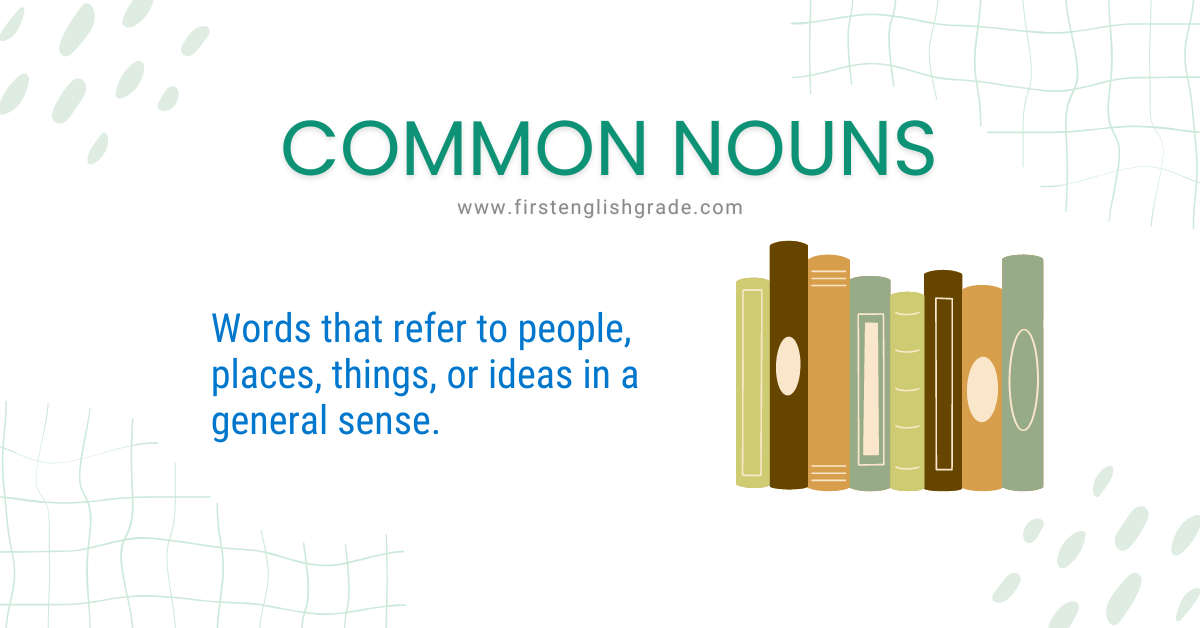Common nouns, the essential words we use daily, form the base of our language. Curious to understand how these simple yet powerful words shape our communication? Let’s unravel the essence of common nouns by exploring their definition, types, and practical examples.
Common Noun Definition
Common nouns are everyday words that refer to people, places, things, or ideas in a general sense. They lay the groundwork for any sentence, giving it substance and clarity. For example, when we say “dog,” “city,” or “love,” we’re using common nouns.
Common Noun Examples:
I saw a dog at the park.
She lives in the city.
Love makes the world a better place.
Types of Common Nouns
Let’s explore the different types of common nouns:
Singular and Plural:
Singular common nouns refer to a single item, while plural common nouns indicate multiple items. See the table below for a clear illustration.
| Singular | Plural |
| Cat | Cats |
| Book | Books |
| Flower | Flowers |
Countable and Uncountable:
Countable common nouns can be quantified with numbers (e.g., “two books”), while uncountable common nouns cannot be expressed in discrete numbers (e.g., “water” or “love”). Check out these examples:
| Countable | Uncountable |
| Chair | Furniture |
| Apple | Happiness |
| Friend | Knowledge |
Concrete and Abstract:
Concrete common nouns are tangible and can be experienced through the five senses, while abstract common nouns represent ideas, emotions, or concepts. Have a look at these:
| Concrete | Abstract |
| Table | Honesty |
| Tree | Freedom |
| Music | Courage |
Types of Nouns in English Grammar!
Identifying Common Nouns in Sentences
Now, let’s master the art of spotting common nouns in sentences. By following these tips and tricks, you’ll become an expert in no time:
Find the “Who” or “What”: Common nouns typically answer the questions “Who?” or “What?” in a sentence. For example, in “The sun shines brightly,” the word “sun” answers the question “What shines brightly?”
Identify General References: Common nouns usually refer to things generally rather than specific entities. For instance, in “She bought a car,” the word “car” doesn’t refer to a particular vehicle model.
Using Common Nouns in Context
Understanding subject-verb agreement is crucial when dealing with common nouns. Remember, singular nouns take singular verbs, and plural nouns take plural verbs.
For instance:
The cat is sleeping. (singular)
The cats are playing. (plural)
Additionally, familiarize yourself with common collocations and phrases that involve specific common nouns. For example, “cup of coffee,” “a bunch of flowers,” or “piece of cake.”
20 Examples of Common Nouns Used in Sentences
Here are 20 examples of common nouns used in sentences:
- Car: My brother drives a sleek car.
- City: New York City is known for its vibrant atmosphere.
- Book: She lost her favorite book in the library.
- Teacher: Mr. Smith is an excellent teacher who inspires his students.
- Dog: The friendly dog wagged its tail and greeted the guests.
- Ocean: The waves crashed against the rocks by the ocean.
- School: The children were excited to go back to school after summer vacation.
- Chair: Please find a comfortable chair to sit in.
- Music: The soothing music relaxed everyone in the room.
- Computer: I need to buy a new computer for my online classes.
- Family: The whole family gathered for a joyful reunion.
- Rain: The farmers were relieved to see the rain after a long drought.
- River: They enjoyed a peaceful picnic by the river.
- Doctor: The doctor prescribed some medicine for her cold.
- Sun: The warm rays of the sun brighten up the day.
- Friend: Sarah and Jane have been best friends since childhood.
- Coffee: He ordered a hot cup of coffee to start his day.
- Mountain: The climbers reached the summit of the towering mountain.
- Shirt: He bought a new blue shirt for the party.
- Time: Time flies when you’re having fun.
Common Nouns vs. Proper Nouns
The Difference:
You might wonder how common nouns differ from proper nouns. Well, while common nouns refer to general things, proper nouns are specific and unique names for particular entities. For instance, “London” is a proper noun because it specifically identifies a particular city, while “city” is a common noun as it refers to any urban area.
When to Capitalize?
When it comes to capitalization, proper nouns always begin with a capital letter. On the other hand, common nouns are only capitalized when they appear at the beginning of a sentence.
For example:
Paris is the capital of France. (Proper noun)
Books are better than movies. (Common noun)
Common Noun Exercises
Identify the common nouns in the sentences provided in the exercises below. You can check the answers key at the end of each exercise for confirmation.
Exercise 1: Identify the Common Noun(s)
- The sun sets in the west.
- Lisa borrowed a fascinating book from the library.
- The little girl played with her fluffy cat.
- Our school organized a trip to the local museum.
- The chef prepared a delicious meal for the guests.
Answers:
- sun
- book
- girl, cat
- school, museum
- chef, meal
Exercise 2: Identify the Common Noun(s)
- The sound of music filled the auditorium.
- The kids played with colorful balloons at the birthday party.
- The young couple walked hand in hand along the sandy beach.
- The doctor recommended a daily dose of medicine.
- The old tree provided shade in the scorching heat.
Answers:
- music, auditorium
- kids, balloons, party
- couple, beach
- doctor, dose, medicine
- tree, shade, heat
Exercise 3: Identify the Common Noun(s)
- The car engine roared as it accelerated.
- The students listened to the inspiring speech by the guest speaker.
- The new restaurant offers a variety of delicious dishes.
- We visited the famous museum to see ancient artifacts.
- The dog wagged its tail, happy to see its owner return.
Answers:
- car, engine
- students, speech, speaker
- restaurant, dishes
- museum, artifacts
- dog, tail, owner
FAQs
Q: What is a common noun?
A common noun refers to a general, non-specific entity or thing, such as “dog,” “city,” or “book.” It doesn’t denote a particular person, place, or thing, but rather a class or category of entities.
Q: How do common nouns differ from proper nouns?
While common nouns refer to general things (e.g., “student”, “teacher”), proper nouns specifically identify unique entities (e.g., “Ms. Smith,” “New York City”). Proper nouns are capitalized, while common nouns are not unless they start a sentence.
Q: Can you provide examples of different types of common nouns?
Certainly! Common nouns can be categorized into various types: concrete (e.g., “table”), abstract (e.g., “love”), countable (e.g., “chair”), and uncountable (e.g., “furniture”).
Q: What is the importance of understanding common nouns?
Understanding common nouns is crucial as they form the basis of language. They help us communicate effectively by referring to everyday objects, places, concepts, or groups without using specific names.
Q: How can I identify common nouns in a sentence?
Common nouns are typically non-specific and can be spotted as regular names for people, animals, places, things, or ideas. Common nouns are only capitalized if they’re at the start of a sentence or in a title; otherwise, they stay in lowercase.
Q: Are there rules for using common nouns in sentences?
There are no strict grammatical rules for using common nouns. However, they must agree in number (singular or plural) with other elements in the sentence and should be used appropriately based on context.
Q: Can common nouns change forms?
Yes, common nouns can change forms to indicate plurality (e.g., “cat” becomes “cats”) or possessiveness (e.g., “dog” becomes “dog’s” or “dogs'”). However, unlike some verbs, they don’t typically have tense variations.




